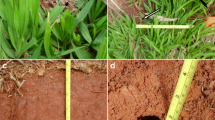In leaf-cutting ants, the handling of waste materials from the fungus culture increases the risk of infection. Consequently, ants should manage their waste in a way that minimizes the spread of diseases. We investigated whether in Acromyrmex lobicornis, waste-worker ants (a) also perform roles in foraging or mound maintenance, (b) are morphologically different than other ant workers, and (c) are aggressively discriminated by other worker ants from the same colony. In addition, we investigated whether the location of external waste piles minimizes the probability that wastes spread to the ant nest. In the field, we (a) marked with different colours waste-workers, foragers and mound-workers and monitored whether these ants interchanged their tasks; (b) measured head width, head length, hind femur length and total length of waste-workers; foragers and mound-workers; (c) forced field encounters between waste-workers and foragers, and (d) measured the cardinal orientation of the waste piles in relation to the colony mound. Waste-worker ants did not perform other function outside the nest; neither foragers nor mound-workers managed the waste. Moreover, waste-workers were smaller than foragers and mound-workers, and were attacked if they tried to enter their nest using foraging entrances. The location of external refuse dumps also appears to reduce contamination risks. Waste piles always were down-slope, and often followed the prevailing wind direction. The importance of behaviours such as the division of labour, aggressions against waste-workers and nest compartmentalization (i.e., the orientation of external waste piles) to minimize the spread of pathogens is discussed.


Similar content being viewed by others
REFERENCES
Bot, A., Currie, C., Hart, A., and Boomsma, J. (2001). Waste management in leaf-cutting ants. Ethol. Ecol. Evol. 13: 225–237.
Cherrett, M. (1989). Leaf-cutting ants, biogeographical and ecological Studies. In H. Lieth and M. Werger (eds.), Ecosystems of the World 14b (pp. 473–488). N.Y.: Elsevier.
Currie, C., Scott, J., Summerbell, R., and Malloch, D. (1999). Fungus-growing ants use antibiotic-producing bacteria to control garden parasites. Nature 398: 701–704.
Farji-Brener, A. G. (2000). Leaf-cutting ant nests in temperate environments: Mounds, mound damages and nest mortality rate in Acromyrmex lobicornis. Stud. Neotrop. Faun. Environm. 35: 131–138.
Farji Brener, A. G., and Ruggiero, A. (1994). Leaf-cutting ants (Atta and Acromyrmex) inhabiting Argentina: Patterns in species richness and geographical ranges sizes. J. Biog. 21: 535–43.
Farji-Brener, A. G., and Sasal, Y. (2003). Is dump material an effective small-scale deterrent to herbivory by leaf-cutting ants? Ecoscience 10: 151–154.
Feener, D., and Moss, K. (1990). Defense of parasites by hitchhikers in leaf-cutting ant: A quantitative assessment. Behav. Ecol. Sociobiol. 26: 17–29.
Fernandez-Marín, H., Zimmerman, J., and Wcislo, W. (2003). Nest-founding in Acromyrmex octospinosus (Hymenoptera, Formicidae, Attini): Demography and putative prophylactic behaviours. Ins. Soc. 50: 304–308.
Fisher, P., Stradling, D., Sutton, B., and Petrini, L. (1996). Microfungi in the fungus gardens of the leaf-cutting ant Atta cephalotes: A preliminary study. Mycol. Res. 100: 541–546.
Franks, N., Britton, N., Sendova-Franks, A., Denny, A., Soans, E., Brown, A., Cole, R., Havardi, R., Griffiths, C., and Ellis, S. (2003). Centrifugal waste disposal and the optimization of ant nest craters. Anim. Behav. 67: 965–973.
Gordon, D. M. (1996). The organization of work in insect societies. Nature 380: 121–124.
Hart, A., and Ratnieks, F. (2001). Task partitioning, division of labour and nest compartmentalization collectively isolate hazardous waste in the leaf-cutting ant Atta cephalotes. Behav. Ecol. Sociobiol. 49: 387–392.
Hart, A., Anderson, C., and Ratnieks, F. (2002). Task Partitioning in leaf cutting ants. Acta Ethol. 5: 1–11.
Hölldobler, F., and Wilson, E. O. (1990). The ants. Berlín, N.Y.: Springer-Verlag.
Poulsen, M., Bot, A., Nielsen, M., and Boomsma, J. (2002). Experimental evidence for the costs and hygienic significance of the antibiotic metapleaural gland secretion in leaf-cutting ants. Behav. Ecol. Sociobiol. 52: 151–157.
Roschard, J., and Roces, F. (2003). Cutters, carriers and transport chains: Distance-dependent foraging strategies in the grass-cutting ant Atta vollenweideri. Insect. Soc. 50: 237–244.
Schmid-Hempel, P. (1998). Parasites in social insects. Princeton, NJ: Princeton University Press.
ACKNOWLEDGMENTS
We thank W. Wcislo and two anonymous referees for their helpful comments. CONICET (Argentina) partially supported this study.
Author information
Authors and Affiliations
Corresponding author
Rights and permissions
About this article
Cite this article
Ballari, S., Farji-Brener, A.G. & Tadey, M. Waste Management in the Leaf-Cutting Ant Acromyrmex lobicornis: Division of Labour, Aggressive Behaviour, and Location of External Refuse Dumps. J Insect Behav 20, 87–98 (2007). https://doi.org/10.1007/s10905-006-9065-9
Published:
Issue Date:
DOI: https://doi.org/10.1007/s10905-006-9065-9




